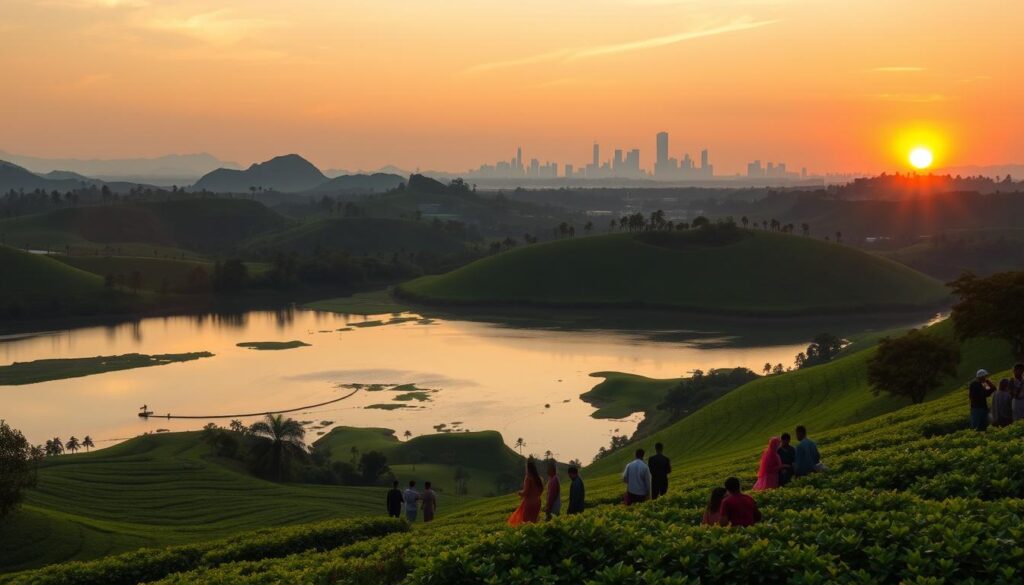Sri Lanka’s Tourism Industry Sees Resurgence Ahead of 2024

As 2024 approaches, Sri Lanka’s tourism is making a strong comeback. In March, the country saw a 66.6% increase in international tourists, reaching 209,181 visitors. This upswing is a positive sign, although it hasn’t yet matched the highs of before the pandemic.
Until March, 635,784 tourists had visited, showcasing the travel industry’s recovery in Sri Lanka. Europe and Asia are the main sources, with 58.6% from Europe and 34.6% from the Asia-Pacific. These numbers highlight the country’s worldwide appeal.
The tourism sector is bouncing back after a tough period, drawing a wide range of tourists. The largest group was from India, making up 15.2% of March’s tourists. Russia, the United Kingdom, Germany, and China also contributed significantly. These countries are crucial to Sri Lanka’s tourism success and its goals for 2024 tourism trends Sri Lanka is targeting.
OMP Sri Lanka continues to monitor economic and industry developments, focusing on sustainable growth and the nation’s prosperity.
Insights on the Revitalization of Sri Lanka Tourism
The tourism industry in Sri Lanka is making a big comeback. It’s a key earner of foreign money and creates many jobs. Europe and Asia-Pacific are big players, bringing in 58.6% and 34.6% of tourists respectively as of March 2024.

This progress comes from working together with local and global groups. The European Union (EU) and the United Nations Development Programme (UNDP) are helping. They aim to refresh tourism in Sri Lanka and build a strong, sustainable future.
Tourist Arrivals and Regional Contributions
There’s a wider mix of tourists now, from the Americas, Middle East, and Africa. Together, they add up to 6.8% of visitor arrivals in Sri Lanka. This variety shows Sri Lanka’s growing global appeal.
Top Contributing Markets and Their Impact
India is at the top with 15.2% of tourist arrivals by March 2024. Following closely are Russia, the UK, Germany, and China. These countries boost visitor numbers and the Sri Lanka travel economy. Poland is also emerging as a promising market.
Projected Growth in International Tourist Arrivals
The aim is for international tourists in Sri Lanka to hit 3 million by the end of 2024. Offering free visas to people from China, India, and Russia should help. It’s part of a plan to offer unique travel experiences and support sustainable tourism.
Efforts to boost tourism in Sri Lanka get a lot of international support (for more, see agricultural developments and educational reforms). These efforts promise a bright future for Sri Lanka’s tourism, overcoming challenges and aiming for inclusive growth.
Enhancing Sri Lanka’s Appeal to Diverse Markets
The travel industry in Sri Lanka is ready for big changes in 2024. It’s adapting to new travel trends and what tourists want. It’s working on attracting more types of travelers from around the world.
Strategies for Tourism Growth in the Coming Year
Sri Lanka is focusing on tourists who spend a lot. This is to increase how much visitors spend, helping the economy. Sri Lanka’s Colombo Stock Exchange is doing really well. This shows the country’s economy is strong, attracting investments in tourism.
Plans to Elevate Tourist Experiences and Spending
Sri Lanka wants to offer better experiences to tourists, aiming to increase their spending from $250 to $400 by 2024. It plans on improving boutique hotels and special attractions. This will attract tourists looking for unique and cultural experiences.
New Campaigns and Visa Policies to Boost Arrivals
New ads and easier visa rules are coming to boost Sri Lanka’s travel industry. They’re introducing free tourist visas for people from 35 countries. This aims to increase visitor numbers. The “So Sri Lanka” campaign targets important markets like China, Britain, France, Germany, and India. It promotes Sri Lanka as the top choice for unique and sustainable trips after the pandemic.
| Year | Expected Tourist Arrivals | Tourism Revenue (USD) |
|---|---|---|
| 2021 | 2.3 Million | $1.88 Billion |
| 2024 | 3 Million | Projected $5 Billion |
These wide-ranging plans aim to do more than recover Sri Lanka’s travel industry. They’re about making the country a top destination in global tourism by 2024.
Conclusion
Sri Lanka is at a crucial point in fixing its economy, and the tourism industry Sri Lanka shines as a ray of hope. Predictions say tourism will bounce back in 2024, thanks to the government and others working hard. In 2023, tourism already made almost US Dollar 2 billion, showing we might hit 2018’s high of US Dollar 4.4 billion again. This bounce-back highlights how tourism can greatly help the economy, fitting well with Sri Lanka’s growing GDP and improving finances.
Sri Lanka’s big push to make tourism better is clear. They’re making the visitor experience better with new marketing, easier visa rules, and better safety. They’re also focusing on training for guides, helping them connect better with tourists from around the world.
The goal to welcome six million tourists by 2025 aims to earn $10 billion and support over 402,000 workers in tourism. This plan shows how important tourism is for a thriving, fair Sri Lanka. With more money coming in, lower inflation, and a stronger economy, tourism is key to reducing poverty and ensuring everyone grows together. The tourism sector stands at the center of Sri Lanka’s dream for a stable, successful future, making its mark worldwide.



